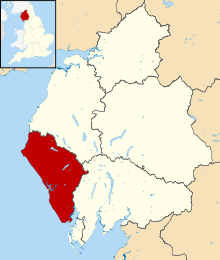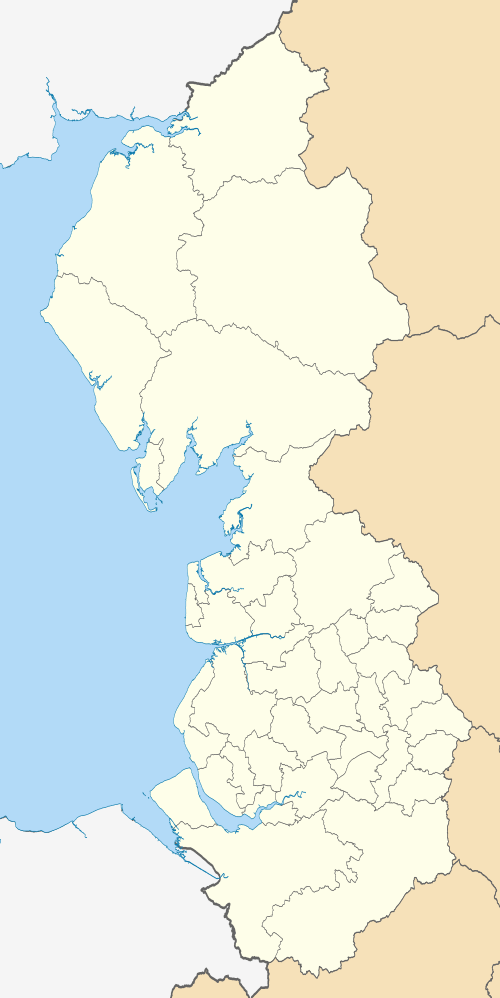Borough of Copeland
Coordinates: 54°25′52″N 3°23′20″W / 54.431°N 3.389°W
The Borough of Copeland is a local government district and borough in western Cumbria, England. Its council is based in Whitehaven. It was formed on 1 April 1974 by the merger of the Borough of Whitehaven, Ennerdale Rural District and Millom Rural District. The population of the Non-Metropolitan district at the 2011 Census was 70,603.[1]
The name is derived from an alternative name for the Cumberland ward of Allerdale above Derwent, which covered roughly the same area.
There are different explanations for the name. According to a document issued at the time of the borough's grant of arms, the name is derived from kaupland, meaning "bought land," referring to an area of the Forest bought from the estate of St Bees Priory.[2] However, Angus Winchester (1985) holds that the name derives from the time of the Irish-Norse invasion of the area in the tenth century (Wainwright 1975). According to this explanation, the area was purchased from the Kingdom of Strathclyde, possibly with loot from Ireland. Geoffrey Hodgson (2008) argues that this Viking invasion accounts for the high frequency of the surname Hodgson in the area.
In 2014 the borough of Copeland was found to have the fattest population in England with a percentage of 75.9% being either overweight or obese (BMI greater than 25) according to official PHE statistics.[3][4]
Governance
Elections to the borough council are held every four years, with currently 51 councillors being elected at each election. Since the first election in 1973 the council has been under Labour control, apart from between 1976 and 1979 when it was under no overall control. As of the 2015 election the council is composed of the following councillors:
| Party | Councillors | |
| Labour Party | 29 | |
| Conservative Party | 17 | |
| Independent | 5 | |
Directly-elected mayor
On 22 May 2014 a referendum was carried out in the borough to change the style of governance in Copeland to a directly-elected mayor, after campaigners from the Time For Change team successfully obtained enough signatures from 5% of the electorate in a petition. The referendum result was: For: 12,671; Against: 5,489.[5]
The first election for mayor was held on 7 May 2015 and Mike Starkie (Independent) was elected by 15,232 votes to the Labour Party candidate Steve Gibbon's 14,259 votes.[6]
Notes
- ↑ "Non-metropolitan district population 2011". Retrieved 25 January 2016.
- ↑ Arms of Copeland Borough Council, document issued at time of grant of arms
- ↑ "Revealed: the fattest towns and cities in England". The Telegraph. 4 Feb 2014. Retrieved 16 September 2015.
- ↑ "England's fattest areas: Copeland 'most overweight borough'". BBC. 4 Feb 2014. Retrieved 16 September 2015.
- ↑ Copeland votes for elected Mayor in referendum ITV Border, 23 May 2014. Retrieved 2 December 2014
- ↑ https://copeland.moderngov.co.uk/mgElectionAreaResults.aspx?ID=27&RPID=90040
References
- Hodgson, Geoffrey M. (2008) Hodgson Saga, second edition (Standon, Hertfordshire: Martlet Books).
- Wainwright, F. T. (1975) Scandinavian England: Collected Papers (Chichester: Phillimore).
- Winchester, Angus J. L. (1985) 'The Multiple Estate: A Framework for the Evolution of Settlement in Anglo-Saxon and Scandinavian Cumbria', in Baldwin, John R. and Whyte, Ian D. (eds) (1985) The Scandinavians in Cumbria (Edinburgh: The Scottish Society for Northern Studies), pp. 89–101.


